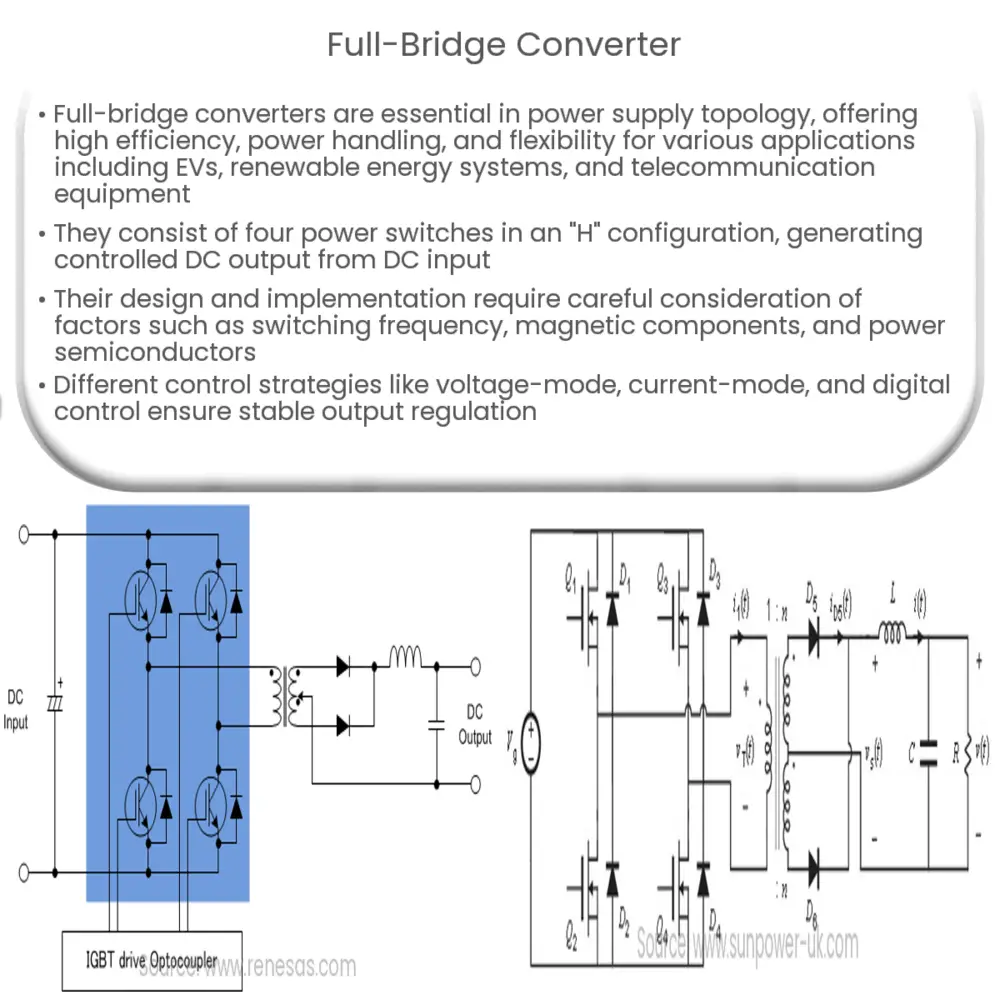A full-bridge converter is a power electronics topology that efficiently converts DC voltage, offering high performance, isolation, and flexibility for various applications.

Full-Bridge Converter: An Essential Power Supply Topology
Introduction
Full-bridge converters have emerged as a critical power supply topology, widely utilized in various industries for applications that demand high efficiency and reliability. These converters have become indispensable components of modern power electronics systems, including electric vehicles, renewable energy, and telecommunications. In this article, we will explore the fundamentals of full-bridge converters, their advantages, and their practical applications.
Basics of Full-Bridge Converters
At the heart of a full-bridge converter is a power electronics circuit, which consists of four power switches arranged in an “H” configuration. The converter is designed to process input DC voltage, and through the use of pulse-width modulation (PWM), it generates an output DC voltage with a controlled magnitude and polarity. The output voltage can be either higher or lower than the input voltage, depending on the specific converter topology.
Typically, full-bridge converters are employed in conjunction with transformers and filtering components, forming an isolated DC-DC converter. The full-bridge topology offers numerous benefits, including the ability to handle high input voltages, high output currents, and minimal stress on the power switches. Additionally, the converter’s isolation ensures that the input and output grounds are separate, eliminating the risk of ground loops and enhancing safety.
Advantages of Full-Bridge Converters
Full-bridge converters offer several advantages over other topologies, making them the preferred choice for many applications. Some of these benefits include:
- Efficiency: Full-bridge converters exhibit high efficiency, with levels often exceeding 90%. This efficiency is primarily due to the reduced conduction losses in the power switches and the employment of zero-voltage switching (ZVS) or zero-current switching (ZCS) techniques.
- Power Handling: The full-bridge configuration enables the converter to handle high input voltages and output currents, making it suitable for high-power applications.
- Isolation: By incorporating a transformer in the design, full-bridge converters can achieve galvanic isolation between the input and output stages, enhancing safety and eliminating ground loop issues.
- Flexibility: Full-bridge converters can be designed to produce a wide range of output voltages and currents, making them adaptable to various applications and requirements.
- Reliability: The full-bridge topology evenly distributes the power dissipation across its switches, reducing the thermal stress on the components and increasing their overall reliability.
Applications of Full-bridge Converters
Due to their advantages and flexibility, full-bridge converters are employed in a variety of applications across different industries. Some common examples include:
- Electric vehicles (EVs) and hybrid electric vehicles (HEVs): Full-bridge converters are used in battery chargers, DC-DC converters, and energy management systems to ensure optimal performance and efficiency.
- Renewable energy systems: Solar inverters and wind turbine converters utilize full-bridge topologies for voltage regulation and power conversion.
- Telecommunication equipment: Full-bridge converters are used in power supplies for base stations, routers, and other networking devices, ensuring stable and efficient operation.
In conclusion, full-bridge converters play a crucial role in modern power electronics, providing efficient and reliable power conversion for various applications. In
the second part of this article, we will delve deeper into the design considerations, control strategies, and practical implementation of full-bridge converters.
Design Considerations for Full-Bridge Converters
Designing a full-bridge converter involves careful consideration of several factors to optimize performance, efficiency, and reliability. Some of these factors include:
- Switching Frequency: The selection of an appropriate switching frequency is crucial for balancing efficiency, size, and cost. Higher frequencies lead to smaller passive components but may increase switching losses.
- Magnetic Components: Transformer and inductor design plays a critical role in achieving high efficiency and maintaining proper regulation of the output voltage and current.
- Power Semiconductors: The choice of power switches, such as MOSFETs or IGBTs, depends on factors like voltage rating, current capacity, and switching speed.
- Cooling and Thermal Management: Effective cooling strategies must be implemented to dissipate heat and ensure reliable operation of the converter.
- Control Strategy: A suitable control strategy must be chosen to regulate the output voltage and current, with options such as voltage-mode control, current-mode control, or more advanced techniques like digital control.
Control Strategies for Full-Bridge Converters
Control strategies play an essential role in the performance of full-bridge converters, ensuring stable and accurate output voltage and current regulation. Some common control strategies include:
- Voltage-Mode Control: In this approach, the output voltage is compared with a reference voltage, and the error signal is used to adjust the PWM duty cycle, thereby regulating the output voltage.
- Current-Mode Control: Current-mode control involves regulating both the output voltage and the inductor current. This method offers improved transient response and better overall performance compared to voltage-mode control.
- Digital Control: Digital control strategies employ microcontrollers or digital signal processors (DSPs) to implement sophisticated control algorithms, offering precise control, adaptive capabilities, and advanced diagnostic features.
Practical Implementation of Full-Bridge Converters
The implementation of full-bridge converters in real-world applications requires attention to detail and adherence to best practices to ensure optimal performance, efficiency, and reliability. Some practical aspects to consider include:
- Layout and Component Placement: Proper layout and component placement are essential for minimizing parasitic inductances, reducing electromagnetic interference (EMI), and ensuring good thermal management.
- Protection Features: Implementing protection features, such as overvoltage, overcurrent, and overtemperature protection, can enhance the safety and reliability of the converter.
- System Integration: When integrating full-bridge converters into larger systems, it is crucial to consider aspects like input/output filtering, control signal interfacing, and synchronization with other converters.
In summary, full-bridge converters offer numerous benefits, making them a popular choice for a wide range of applications in various industries. A thorough understanding of the design considerations, control strategies, and practical implementation can help engineers optimize the performance, efficiency, and reliability of these essential power supply topologies.

